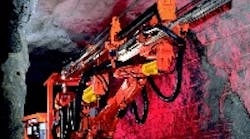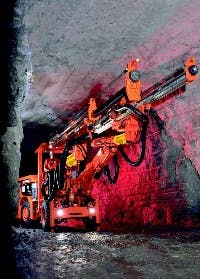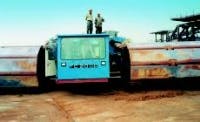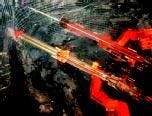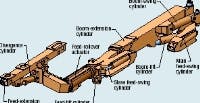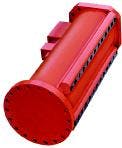The Tamrock Axera 226 — built in Lyon, France, by Sandvik Mining and Construction — is a rubbertired, twin-boom rock-drilling machine. Typically used for underground hardrock mining and tunneling applications, the machine is designed to drill a series of holes in the face, sides, roof, and floor of a chamber without being moved. It can produce cross-sectional areas between 6- and 40 m2 from one position. Depending on the application, rock bolts or explosives are inserted into the holes. With the drills located at the outboard ends of the booms, the risk of injury to the operator and damage to the main machine from falling rock and debris is minimized during the drilling operation.
Power comes from a Deutz BF4M2012 diesel engine that delivers 74 kW (100 hp). The rig carries twin 55-kW hydraulic power units that produce 18 to 24 kW of percussive power. A drill mechanism uses a combination of percussion and rotation of the drill bit. A manually operated, hydraulically controlled drilling system — with multiple automatic functions — allows high drilling performance with good drill-steel economy and high reliability.
The dual-boom design extends the time period between drill-bit changes. In addition, one boom can work while the other is being set up. A series of rugged cylinders coordinates the X-Y boom movements and manipulates the feed, making control of the drill simple and logical. Each boom includes a 360° helical rotary actuator that enables the operator to roll the feed beam over to drill into face, side, roof, and floor surfaces. The actuator also can position the feed for full visibility over the top of the feed and the drill bit.
Helac Corp., Enumclaw, Wash., manufactures the Model L30-95-SRL-360-L1-C-H helical rotary actuators. The rotary actuators are integral parts of the machine, mounted in-line between the booms and drill heads. Their large, circular, integral-shaft flange — with drilled and tapped bolt circle — is used to attach the actuator to the boom.
The drill head assembly is attached to the actuator's octagonal rear mounting flange. The actuator's shaft remains stationary with the boom while the housing and drill head rotate. (The actuator also incorporates a drilled and tapped mounting rail on the housing. Sandvik uses the rail mounting style for other rotating applications.)
The unique characteristics of the helical rotary actuator make it ideal for this application. Its slidingspline operating concept (see boxed description) produces very high output torque (in this case: 90,000 lb-in. at 3000 psi) from a compact configuration. The actuator measures 33 in. in overall length with an 8-in. housing diameter. It weighs 415 lb.
Because all spline teeth remain engaged at all times, loads are equally distributed over the teeth This results in exceptional durability and high tolerance to the shock loads inherent in rock drilling. Backlash is almost negligible — approximately 1 ° . Helac's patented integral bearing design enables the actuator to support heavy radial, moment, and thrust loads without the need for additional, external bearings.
In the Axera 226 machine, one actuator supports the entire drill head assembly on each boom. Because all sealing occurs against smooth, cylindrical surfaces, internal bypass and external leakage has effectively been eliminated, resulting in smooth positioning capabilities and zero drift after a position has been selected. The actuator has an integral dual counterbalance valve that further improves positioning accuracy and adds an extra margin of safety in case of system failure. In short, the helical rotary actuator functions as rotating device, mounting bracket, and bearing support — all in one component.
For more information on rotary helical actuators, call (360) 825-1601 or visit www.helac.com.
Hydraulics for the long haul
Fugo S.A., a Polish special machine manufacturer, has developed a powerful crawler transporter for an Indian coal mine operator — the TC2000 transporter. The transporter has a gigantic creeper band made from metal slats on the right and left hand sides. An extremely wide support surface not only provides stability, but also ensures that the amazing motive forces are transmitted to potentially uneven ground surfaces.
An operator cabin is located between the two creeper bands, and its upper edge is flush with the bands. A major part of the TC2000's upper surface is taken up by a lifting mechanism, which consists of a vertical movable platform. The transporter can, therefore, move under the item to be transported and lift it prior to transporting it.
The TC2000 is used in coal mining primarily to move long conveyor belt system drive units and tensioners without disassembling them. Although dismantling, moving, and reassembling the separate assemblies would not require specialty equipment, it is easier, quicker, and more cost-effective to use the TC2000.
More than brute strength
Neyveli Lignite Corp. Ltd., a major coal mining company in India, needed a transporter that could move stations weighing as much as 550 tonnes. These stations house four 1250 kW drive motors for belt conveyor systems. In addition, the solution must withstand hostile environmental conditions. For example, strong winds at the work site would pose a challenge to safety when transporting the heavy drive units. Moreover, tropical weather conditions prevail in Neyveli. This means fluctuations in temperature and humidity can promote condensation, which poses an additional threat to safety and reliability — especially with electrical systems and electronic controls.
Fugo S.A. was awarded the contract to modify a machine in cooperation with the Polish company Poltegor Projekt and India's Macnally Bharat Engineering. Bosch Rexroth developed the hydraulic system for this machine and delivered the modules for supplying the drive unit.
Jaroslaw Wasikowski, manager of Bosch Rexroth's branch in Posen, Poland, outlines the scope of their undertaking. "We supplied motors, pumps, and hydraulic cylinders for this project. The TC2000 is powered by a total of four A6VM500 bent-axis hydraulic motors, a pair for each crawler chain.
The motors are fitted with a twoposition switching arrangement that not only produces high tractive power on inclines, but enables rapid travel on level ground." The motors are rated for maximum flow to 1000 lpm (264 gpm) at speeds to 2000 rpm with a nominal pressure rating of 350 bar (5100 psi). Maximum torque output of the motors is 2785 N-m (2054 lb-ft).
The wide control range of the A6VM500 motors produces output power to match torque and speed requirements. Motor torque increases with the pressure differential between the high-and low-pressure side and with increasing displacement. They reduce cost of the powertrain by eliminating the need for shiftable gearboxes and allow using a smaller pump than if fixed-displacement motors were used.
Wasikowski continues, "Each pair of drive motors is supplied by two A4VG250 variable-displacement, axial-piston pumps with a sensitive proportional control." The pumps have a nominal pressure rating of 400 bar (5800 psi) and generate flow to 600 lpm (158.4 gpm) at 2400 rpm. Output flow is proportional to drive speed and variable through the pump's swashplate angle control, which has over-center capability to reverse the direction of output flow when necessary. The pump is also equipped with two pressure relief valves on the high-pressure ports to protect the hydrostatic transmission from overloads.
"All other functions — from lifting using a clamping facility to rotating the platform — are powered by hydraulics, according to Wasikowski. Hydraulic power is produced by a pair of compact A11VO75 variable-displacement, axial-piston pumps." These pumps are driven by the through-shaft of the A4VG250 pumps to conserve weight, reduce cost, and simplify the design. The A11VO75 pumps supply pressurized fluid for four lifting cylinders with a bore of 350 mm and stroke of 800 mm.
Wasikowski explained, "We fitted these cylinders with pressure sensors as means of identifying the center of gravity of the station during transport. Should the center of gravity stray too far from the mid-point of the transporter, then its movement is automatically halted by a PLY."
Overall control of all functions is accomplished by a PLY. The hydraulic drive is controlled locally by a Rexroth MC6 controller. The transporter operator works with two joysticks with which the entire station can be lifted and the transporter drive regulated. "An LCD screen plays an important role by allowing the operator to keep a watchful eye on all important working parameters and to monitor the overall system," said Wasikowski. All basic functions can also be operated by remote control.
A single source
An important innovation with this transporter is its hybrid drive system. Similar to some hybrid cars, the transporter has two drives at its disposal, namely a diesel engine and an electric motor. When the TC2000 is used for relatively short distances, its electric drive is used as an energysaving alternative to the engine.
Initial assembly and commissioning took place at Fugo in Poland. After a successful test run, the crawler transporter was completely dismantled and shipped to India, where it was reassembled and proceeded through final commissioning.
"The benefit that we gained from the realization of this project was that we were able to offer many components from a single source," explained Wasikowski. "System capability continues to play an increasingly important role in modern control and drive technology."
